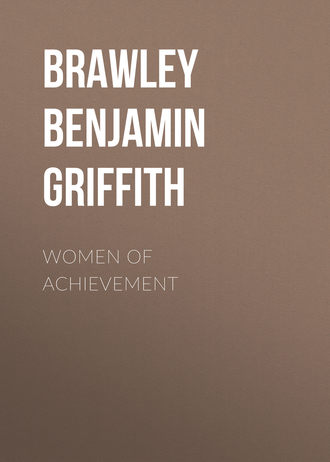 полная версия
полная версияWomen of Achievement
Mary Church was born in Memphis, Tennessee, the daughter of Robert R. and Louisa Ayres Church. When she was yet very young her parents sent her to Ohio to be educated, and here she remained until she was graduated from the classical course in 1884. Then for two years she taught at Wilberforce University in Ohio, and for one year more in a high school in Washington. Desirous of broadening her attainments, however, she now went to Europe for a period of study and travel. She remained two years, spending the time in France, Switzerland, Germany, and Italy, generally improving herself in language. On her return she resumed her work in Washington, and she was offered the registrarship at Oberlin College, a distinct compliment coming as it did from an institution of such high standing. She declined the attractive position, however, because of her approaching marriage to Robert H. Terrell, a graduate of Harvard College and formerly principal of a high school in Washington, who was appointed to a judgeship in the District of Columbia by President Roosevelt.
Since her marriage Mrs. Terrell has written much on topics of general interest and from time to time has formally appeared as a public lecturer. One of her strongest articles was that on Lynching in the North American Review for June, 1904. The centenary of the birth of Harriet Beecher Stowe in 1912 found her unusually well posted on the life and work of the novelist, so that after she lectured many times on the subject she brought together the results of her study in an excellent pamphlet. She was the first president of the National Association of Colored Women's Clubs, was twice re-elected, and, declining to serve further, was made honorary president for life. She was chosen as one of the speakers at the International Congress of Women held in Berlin in June, 1904. Said the Washington Post of her performance on this occasion: "The hit of the Congress on the part of the American delegates was made by Mrs. Mary Church Terrell of Washington, who delivered one speech in German and another in equally good French. Mrs. Terrell is a colored woman who appears to have been beyond every other of our delegates prominent for her ability to make addresses in other than her own language." In a letter to some of the largest newspapers in the country Mrs. Ida Husted Harper said further: "This achievement on the part of a colored woman, added to a fine appearance and the eloquence of her words, carried the audience by storm and she had to respond three times to the encores before they were satisfied. It was more than a personal triumph; it was a triumph for her race."
Mrs. Terrell has ever exhibited an intense interest in public affairs. On the occasion of the discharge of the Negro soldiers in Brownsville, Texas, in 1906, she at once comprehended the tremendous issues involved and by her interviews with men high in the nation's life did much for the improvement of a bad situation. When, some years ago, Congress by resolution granted power to the Commissioners of the District of Columbia to appoint two women upon the Board of Education for the public schools, Mrs. Terrell was one of the women appointed. She served on the Board for five years with signal ability and unusual success, and on the occasion of her resignation in 1912 was given a magnificent testimonial by her fellow-citizens.
It would be difficult to record all the different things that Mary Church Terrell has done or the numerous ways in which she has turned sentiment on the race problem. In recent years she has been drawn more and more to her own home. She is in constant demand as a speaker, however, and one or two experiences or incidents must not pass unremarked. In 1906 she was invited by Prof. Jeremiah W. Jenks to come to Cornell University to deliver her address on the Bright Side of the Race Problem. She was introduced by Prof. F. A. Fetter of the Department of Economics. When she had finished her lecture she was greeted by deafening applause, and then she was surrounded by an eager crowd desirous of receiving an introduction. One enthusiastic woman exclaimed, as she warmly shook the speaker's hand, "I was so glad to hear you say something about the bright side, and – do you know? – every Southern faculty woman was here." A little later she was the guest of honor at a reception in the home of Ex-Ambassador Andrew D. White, the first president of Cornell University.
Just what Mary Church Terrell means as an inspiration to the young women of the Negro race one might have seen some years ago if he could have been present at Spelman Seminary on the occasion of the twenty-fifth anniversary of this the largest school for Negro girls in the world. She was preceded on the program by one or two prominent speakers who tried to take a broad view of the race problem but who were plainly baffled when they came face to face with Southern prejudice. When Mrs. Terrell rose to speak the air was tense with eagerness and anxiety. How she acquitted herself on this occasion, how eloquently she plead, and how nimbly and delicately she met her opponents' arguments, will never be forgotten by any one who was privileged to hear her.
The compliments that have been paid to the eloquence, the grace, the culture, the tact, and the poise of this woman are endless. She exhibits exceptional attainments either on or off the platform. Her words bristle with earnestness and energy, quickly captivating an audience or holding the closest attention in conversation. Her gestures are frequent, but always in sympathetic harmony. Her face is inclined to be sad in repose, but lights quickly and effectively to the soul of whatever subject she touches. Her voice is singularly clear and free from harsh notes. She exhibits no apparent effort in speaking, and at once impresses an audience by her ease, her courage, and her self-abnegation. Through all her work moreover constantly thrills her great hope for the young men and women of her race, so many of whom she has personally inspired.
Such a woman is an asset to her country and an honor to the race to which she belongs.
1
While this sketch is drawn from various sources, I feel specially indebted to Sarah H. Bradford's "Harriet, the Moses of Her People." This valuable work in turn includes a scholarly article taken from the "Boston Commonwealth" of 1863 and loaned to Mrs. Bradford by F. R. Sanborn. This article is really the foundation of the sketch. – B. B.
2
For the further pursuit of this and related subjects the attention of the reader is invited to the author's "The Negro in Literature and Art" (Duffield & Co., New York, N. Y., 1918).



